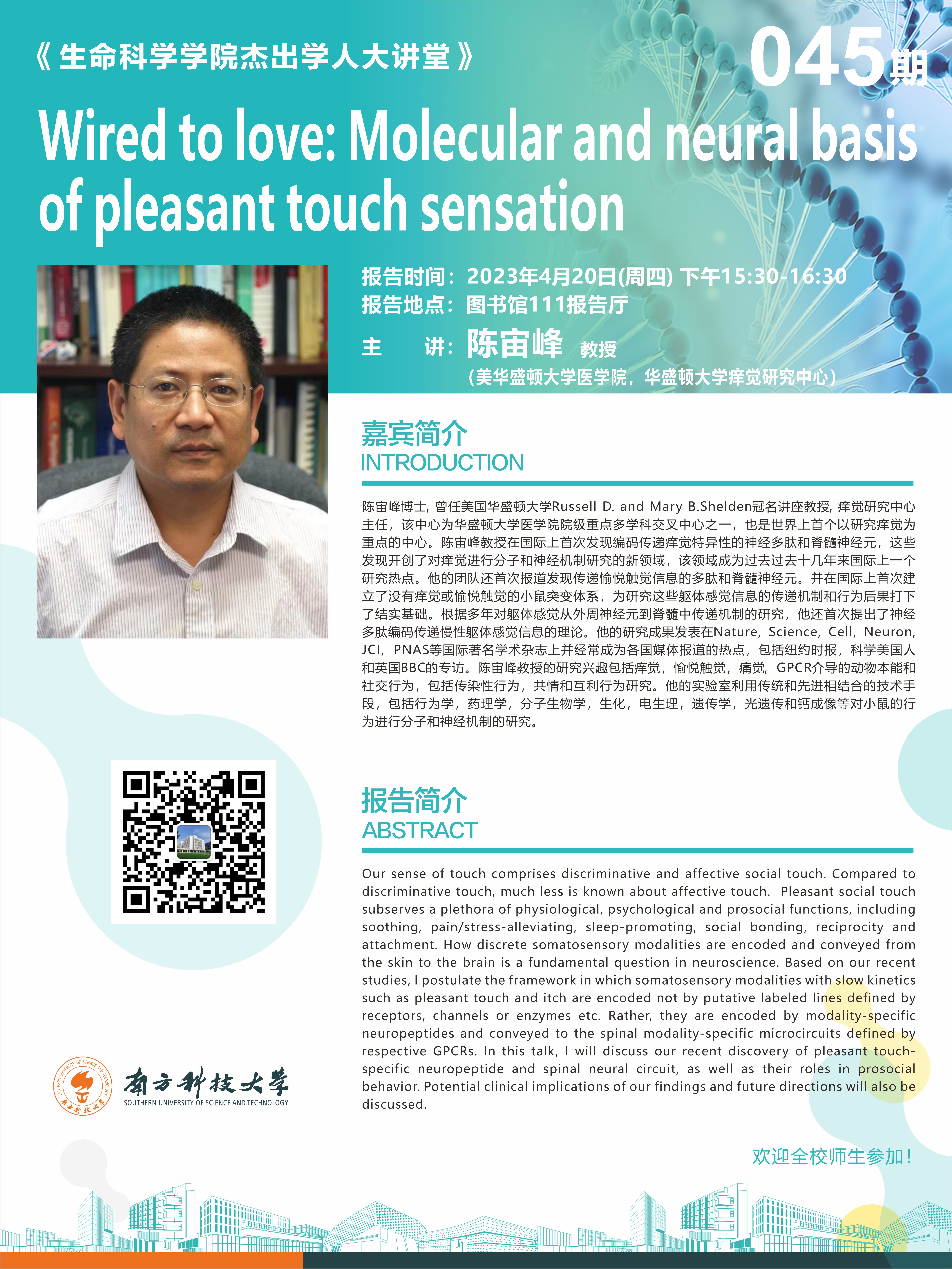
主讲人: 陈宙峰 教授
时间: 2023年4月20日(周四)15:30-16:30
地点: 琳恩图书馆111报告厅
题 目:Wired to love: Molecular and neural basis of pleasant touch sensation
主 讲:陈宙峰 教授
时 间:2023年4月20日(周四)下午15:30-16:30
地 点:琳恩图书馆111报告厅
个人简介:
陈宙峰博士, 曾任美国华盛顿大学Russell D. and Mary B.Shelden冠名讲座教授, 痒觉研究中心主任,该中心为华盛顿大学医学院院级重点多学科交叉中心之一,也是世界上首个以研究痒觉为重点的中心。 陈宙峰教授在国际上首次发现编码传递痒觉特异性的神经多肽和脊髓神经元,这些发现开创了对痒觉进行分子和神经机制研究的新领域,该领域成为过去过去十几年来国际上一个研究热点。他的团队还首次报道发现传递愉悦触觉信息的多肽和脊髓神经元。并在国际上首次建立了没有痒觉或愉悦触觉的小鼠突变体系,为研究这些躯体感觉信息的传递机制和行为后果打下了结实基础。根据多年对躯体感觉从外周神经元到脊髓中传递机制的研究,他还首次提出了神经多肽编码传递慢性躯体感觉信息的理论。他的研究成果发表在Nature, Science, Cell, Neuron, JCI, PNAS等国际著名学术杂志上并经常成为各国媒体报道的热点, 包括纽约时报, 科学美国人和英国BBC的专访。陈宙峰教授的研究兴趣包括痒觉,愉悦触觉,痛觉, GPCR介导的动物本能和社交行为,包括传染性行为,共情和互利行为研究。他的实验室利用传统和先进相结合的技术手段,包括行为学,药理学,分子生物学,生化,电生理,遗传学,光遗传和钙成像等对小鼠的行为进行分子和神经机制的研究。
摘要:
Our sense of touch comprises discriminative and affective social touch. Compared to discriminative touch, much less is known about affective touch. Pleasant social touch subserves a plethora of physiological, psychological and prosocial functions, including soothing, pain/stress-alleviating, sleep-promoting, social bonding, reciprocity and attachment. How discrete somatosensory modalities are encoded and conveyed from the skin to the brain is a fundamental question in neuroscience. Based on our recent studies, I postulate the framework in which somatosensory modalities with slow kinetics such as pleasant touch and itch are encoded not by putative labeled lines defined by receptors, channels or enzymes etc. Rather, they are encoded by modality-specific neuropeptides and conveyed to the spinal modality-specific microcircuits defined by respective GPCRs. In this talk, I will discuss our recent discovery of pleasant touch-specific neuropeptide and spinal neural circuit, as well as their roles in prosocial behavior. Potential clinical implications of our findings and future directions will also be discussed.